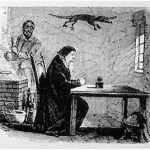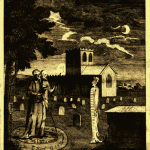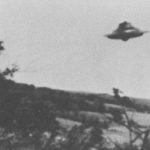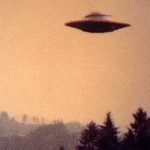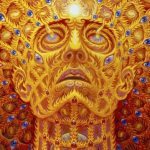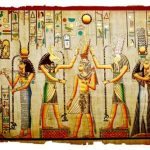To understand the connections between the mid-nineteenth century eruption of spirit communication and the problem of non-local evolutionary intervention, we must briefly examine how the idea of life elsewhere in the universe developed. Early in the seventeenth century, not long after the death of John Dee, there occurred a significant revival of interest in the possibility of other life in “our” universe. Kepler had dreamed of an inhabited Moon, but the Right Reverend John Wilkins, in his That the Moon May Be A World (1638), proposed that “it is probable there may be inhabitants on this other world; but of what kind they are, is uncertain.”
Wilkins goes on to agree with Cardinal Nicholas of Cusa, a late medieval author and a favorite of Dee’s, that the inhabitants of a planet would reflect the nature of that planet. In this, he is using the esoteric attributions concerning the nature of the angelic intelligence of a planet to determine the nature of the imagined physical inhabitants. He also speculates on travel through space; recognizing many of the actual obstacles, such as the vast distances, the incredible speeds required and the length of confinement for the travelers. While the Reverend occasionally lapses into the mystical, his overall grasp of the problem is impressive.
Christian Huygens, in his The Celestial Worlds Discover’d, 1722 edition, sketched out the possibilities of extra-terrestrial life. He thought it likely that the inhabitants of other planets have “reason. . . not different from what it is here.” Huygens’ universal world seems much like the utopian speculation of the late 19th century Fabian socialist or the science fiction author, but he is very modern and practical in conceding that such inhabitants would not necessarily resemble us physically and would have “odd ways, and. . . strange methods of living.”
In the early eighteenth century, one of the giants of English literature, Jonathan Swift, tweaks us in Gulliver’s Travels with images of flying islands hovering like UFO mother-ships. The inhabitants of the floating land, Swift informs us, “have likewise discovered two lesser stars, or satellites, which revolve around Mars.” He then proceeds to give the reader accurate sizes, distances and orbital periods. Of course, no one knew they were accurate until 1877, when Asaph Hall discovered Phobos and Deimos and found that the reality closely matched Swift’s estimates.
Even Voltaire tried his hand at speculative interplanetary fiction. In Micromegas, he described a voyage to Saturn by a visitor from Sirius. Voltaire used his science fiction for his own brand of ironic moralizing. His younger contemporary, Emanuel Swedenborg, not only speculated on extra-terrestrials, he described them in terms more unequivocal than most modern contactees.
With Swedenborg, the spirits and the ETs collide. Along with angels, devils and the dead, Swedenborg often conversed with inhabitants of other planets. Most of his contemporaries dismissed him as a madman or a liar, but we would do well to remember that his psychic abilities seem genuine. There are many documented cases of his psychic skills and his sincerity is beyond question. What then are we to make of a volume such as Earth in the Universe? Swedenborg informs us that most planets have inhabitants, then describes them in images that suggest a painting by Hieronymus Bosch: Moon men speak through their stomachs with a belching noise; Martians have parti-colored faces and dress in robes of tree bark; Saturnians are exceedingly humble, feed on fruit and refuse to bury their dead.
The importance of Swedenborg lies in the essentially religious perspective of his doctrines, his insistence on individual determinism rather than predestined judgment, for example. He had a powerful but indirect influence on Spiritualism, which tended to provide independent support for his views. The inner consistency of this range of material, the point that shocked Rivail, is truly remarkable. Given that Spiritualism grew up independent, for the most part, of Swedenborgian thought, we are led to conclude that spirits, of the dead and other visitors, are real inhabitants of an archetypal realm of internal experience.
Both William Blake in the early nineteenth and Carl Jung in the early twentieth century rediscovered the basic truths outlined by Swedenborg. Blake, as an artist, used Swedenborgian fragments to create his epics of psychic conflict. Jung, using a very Swedenborgian technique of active imagination, made contact with various autonomous archetypal entities. He used this almost shamanic knowledge to help others heal and grow toward a new level of human-ness. Blake and Jung, like Swedenborg, sustained an on-going dialogue with the spirits of the dead. Jung’s Seven Sermons for the Dead, a gnostic tract written at the spirits’ insistence during the depths of World War I, begins, “We have come back from Jerusalem where we found not what we sought.” Like Swedenborg, Jung concludes that heaven and hell are mental states, and that it is the living who have much to teach the dead, not the other way around. After Swedenborg, the psychic intrusion, the invasion of the spirits, was simply a matter of time. The framework was in place, awaiting only the eruption of phenomena to animate its belief system. The question of extra-terrestrial life blurred and merged with the idea of spirits. As spiritualism expanded the mental horizons of the Victorians, the issue of other life in the universe gained a whole new level of meaning.
Thomas Paine, author of The Rights of Man — a contemporary of William Blake and ahead of his time as usual — neatly summed up the change in attitude: “To believe that God created a plurality of worlds, at least as numerous as what we call stars, renders the Christian system of faith at once little and ridiculous, and scatters it in the mind like feathers in the air. The two beliefs cannot be held together in the same mind; and he who thinks he believes in both has thought little of either.” By the mid-nineteenth century, even T. H. Huxley would have agreed with him.
However the scientists, particularly the astronomers, had their share of strange encounters and sightings. They may not have been ghosts and spirits, but the astronomical journals of the early nineteenth century are filled with unexplained reports: octagonal stars in the London skies; great fiery shapes over Switzerland; hurtling globes of light maneuvering above Florence; an immense luminescent form sighted by the inhabitants of Portugal; a strange satellite in the vicinity of Venus; spherical unknowns crossing the face of the moon.
One of the most striking sightings occurred on June 18, 1845, off the island of Malta in the Mediterranean. An object five times the diameter of the moon slowly cruised the island, taking over an hour to complete its passage. It was described as indistinctly seen, giving the impression of two large objects linked or joined together. Malta, interestingly enough, is the origin point of the North Atlantic Coast Megalithic culture, one of the eight original cultures from the beginning of this 5200 year evolutionary cycle.
***
By the mid-1850’s, as the spiritualism movement attained a global status, a wave of books, led by Sir David Brewster’s More Worlds Than One, appeared on the possibility of life on other planets. Most were inspired by the seventeenth century work of Bernard de Fontenelle, Conversations on the Plurality of Worlds, a fantasy, without serious scientific or literary intent. As such, it can considered the first popular work of science fiction. Its nineteenth century admirers, such as Sir David Brewster, thought it a “singular work, written by a man of genius. . .”
These works, by Brewster, Robert Knight and William Cronhelm among others, helped to form a new paradigm, one in which it seemed inevitable that there must be other worlds with intelligent life. The strange sightings continued; snakes in the sky above Texas; fireballs and strange lights in New Jersey; enigmatic auroras on the moon. Schiapereli found channels or canali on Mars, as did Percival Lowell. These were highly competent and respected scientists. Other astronomers continued to witness and report curious sightings; a glowing object was seen from Virginia to South Carolina; in western New York, home of spiritualism, a vast number of round blackish objects darkened the sun as they passed overhead in an endless seeming procession to the East; a similar event was noted in Kattenau, Germany; an observatory in Zacatecas, Mexico, observed luminous objects passing between the earth and the sun, and even took photographs of them.
In 1917, for the five hundredth issue of Observatory magazine, astronomer E.W. Maunder recalled the most striking thing he had seen in 43 years of observation. It happened 35 years earlier, on November 17, 1882.
Two hours after sunset, as Maunder stood watching an aurorial display from the Royal Observatory at Greenwich, he observed that “a great circular disc of greenish light suddenly appeared low in the E.N.E., as though it had just risen.” It moved swiftly, its form lengthening as it passed over head. “When it crossed the meridian and passed just above the moon its form was that almost of a very elongated ellipse. . . Various observers spoke of it as ‘cigar-shaped’ or ‘like a torpedo.’ ” His readers in 1917 would have immediately identified the object as a Zeppelin, a German airship familiar from years of bombing scares. Maunder declares that it was “a definite body,” and that it took less than two minutes for it to pass from horizon to horizon, noting that “nothing could well be more unlike the rush of a great meteor or fire-ball. . .than the steady — though fairly swift — advance of the ‘torpedo.’ ”
Fourteen years later, something like this unknown cigar-shaped object would reappear in the skies over America, triggering a panic, the first UFO hysteria, or flap. For a time, it would rival the level of popular interest generated by spiritualism.
***
San Francisco, California, began to see airships in late October 1896. Walking home one night, a Miss Hegstrom spotted a light floating in the autumn sky. Her report was ignored for a few weeks until more sightings occurred. On All Saints Day, November 1, 1896, a mountain man by the name of Brown spotted an “airship” floating in the morning sky above Bolinas Ridge, just outside the city. The encounter so un-nerved the man that he walked back into town and told his story to a newspaper reporter, then turned around and left, never to be heard from again. This is the first record of the mysterious airship. There would be many more.
On November 17, fourteen years to the day after Maunder’s sighting, the airship descended on Sacramento, California. A bright light, attached to some rather solid structure, was seen by hundreds of witnesses. The consensus was that the object was large, had an oblong shape, with flattened ends, and sported large fan wheels for propulsion and a tiny cabin suspended underneath. Some witnesses claimed to hear voices, even laughter, coming from the craft as it cruised through the twilight. All of this was reported in the local papers and the flap was on. Rumors flew, and any interesting theory found plenty of news space available for its discussion.
Meanwhile, the airship had moved south, appearing over Oakland, California, on November 20. The response from the hundreds of witnesses ranged from fright to delight and once again the newspapers reported every sighting and every theory. As the flap grew, tales reflecting uncontrolled imaginations, and some outright hoaxing and spoofing, crept into the more serious reportage. Given this, the consistencies of the reports are truly remarkable. Weeding out the obvious intrusions, we are left with the image of a propeller driven craft on a wavy flight pattern equipped with a brilliant searchlight and suspended gondola-like cabins.
The airship(s) continued for several days to cruise nightly over the San Francisco area. Various people emerged claiming information about or contact with the occupants of the airship. These contacts proved spurious, though interesting, and the sightings continued all over northern California. In one night, airship sightings were reported from San Francisco, Oakland, Redding, San Jose, Alameda, Tehachapi and Los Angeles. Within another 48 hours, the sightings had spread from Tacoma, Washington, to southern California.
The first true contactee story appeared on December 2, 1896. Two Italian fishermen were offshore from Pacific Grove, just north of San Francisco, when a medium sized craft swooped down and landed on the white sands of the beach. Three occupants emerged and proceeded to carry the light craft into the woods. The fishermen headed their small boat into the shore and started after the men with the craft. One of the occupants turned around and stopped them. When they argued, the man returned to his comrades for instructions. It was finally agreed that the fishermen could approach, but only so far. They glimpsed a sixty foot long cigar-shaped craft with retractable wings, but could not stay to watch it depart.
The following evening, it was reported that a similar craft had crashed near Twin Peaks. Witnesses noticed a release of foul-smelling gas from the balloon-like upper structure and that some of the propellers were bent and twisted. Apparently one of the occupants, a J. D. de Gear, claimed that this was the airship’s initial flight and was in no way connected with all the other sightings. Yet none of this in any way explained the mystery of the airships. It merely obscured the real riddle.
Compounding the confusion was the attitude of the newspapers, particularly the William Randolph Hearst organization. His San Francisco papers downplayed the sightings — “The Result of Beer” read one headline — while his New York paper supported the sightings by announcing that a successful airship had obviously been built, since it was now flying all over California. At the same time, Hearst was trying to use this flap as another means of promoting war between the US and Spain — “Airship to Bomb Havana” read another headline. The influence of the newspapers turned another enigmatic sighting, one of many in the nineteenth century, into the first true Unidentified Flying Object hysteria.
Despite all that, something was happening in the skies over California. Where would the airships turn up next?
***
On April Fool’s Day 1897, Kansas City, Missouri, found the airships wandering through its early evening skies. The performance began around eight o’clock when a powerful searchlight swept the air, the streets, the housetops and bluffs around the town. Naturally, this attracted attention and the streets were soon filled with people watching the show. The light sped across the city, about 45 degrees above the horizon and moving in a rolling or wavy motion. For more than an hour it hovered and wobbled, flashing its light beam along the horizon, then finally it lifted off, growing smaller as it climbed swiftly and vanished to the Northwest. A few minutes later, it was sighted over Everest, Kansas, sixty miles away.
There were thousands of witnesses to the Kansas City sighting, including the governor and many other officials, professionals, and ordinary citizens. All agreed that the unknown vehicle had made abrupt changes in direction and indulged in other strange acrobatic maneuvers. Once, for a few moments, it had extinguished its light and hung over the city as a dark, motionless mass. Then finally, after almost ninety minutes of aerial display, it was gone.
The hysteria began again. The California sightings had faded away in mid-December of 1896. No new sightings had been reported in the intervening months, although speculation had continued as to the source of the mysterious airships. Now, suddenly, it seemed as if the middle section of the nation, its heartland, was under siege by an aerial armada of searchlight equipped airships. The first week of April saw hundreds of reported sighting in Kansas, Nebraska and Missouri, then the phenomenon spread northeastward to Sioux City, and Burlington, Iowa. Following a large wavy pattern across the continent, the airships returned to Nebraska, then turned east through Missouri and Illinois, turning up in Chicago on April 10. People watched the flickering green and red lights from the top of a skyscraper in the Loop.
While the local populace appeared ready to welcome the airships, the scientific community tried to stem the tide by announcing that the lights had been a bright star in the constellation of Orion. Practical Chicagoans who had witnessed the lights snorted at this suggestion. During the April 10 fly-by, photographs had been taken of the mysterious object. A newspaper dealer by the name of Walter McCann snapped two photographs with his son’s box camera around five thirty that morning. The photos were examined by independent experts provided by the newspaper and found to be genuine. They clearly showed that the upper portion of the object was an elongated ovoid with something like the fabric texture of a silk balloon.
As in California, a large variety of deluded fools and confidence tricksters emerged claiming contact with the airships. Inventors appeared briefly, then faded away. The airships sailed on, roughly toward the East, putting in appearances at Kalamazoo, Michigan, (where one airship may have crashed) Oklahoma, (a slower than average airship perhaps) Illinois and Indiana. By this time, the airships’ fame was international.
The Parisian newspaper Figaro picked the story up on April 14, 1897. Noting the thousands of witnesses and the photographs, the paper concludes that “the news seems to be more than a canard.” However, the writer admits that acceptance of the speed and flight characteristics of the airship would require a complete revision of prevailing scientific knowledge and the admission that a new source of power or motive force had been discovered.
By mid-April, a new element appeared, letters from the occupants of the airships. These were just as confusing and contradictory as the other inventor and official representative stories. April 15 saw the airships return to Chicago, where thousands of people filled the streets to watch. Reports also came in from Ripon, Wisconsin, Elkhart, Indiana and Lake Forest, Illinois. In Lynn Grove, Iowa, the airship made a spectacular daylight appearance, cruising above the town and landing a few miles away. A report came in from Cleveland, Ohio, where an airship had been spotted taking off from the waters of Lake Erie. On April 15 alone, additional sightings were reported in St. Louis, Missouri; Birmingham, Iowa; Clarksville, Tennessee; Louisville, Kentucky; and several small towns in Texas.
A few days later, on April 18, the airships appeared over southern Ohio and West Virginia. On April 20, the first cattle abduction and mutilation occurred in Le Roy, Kansas with the farmer a helpless observer. The skin and bones were found a few miles away. The farmer, Alexander Hamilton, happened to be a congressman and an emphatically honest man. His affidavit was witnessed by every significant official in the town.
The sightings continued moving to the East. The climax came on April 30, as the airships glided over Yonkers, New York, at 3 a.m., then sailed out to sea and into oblivion. As suddenly as they had appeared, the airships were gone.
***
The Scientific American, a month after the Yonkers finale, dismissed the whole vast catalogue of sightings with just fifty well-chosen words. Everything, each of the thousands of observations, could be attributed to “creations from the brains of imaginative persons.” Unfortunately, this official attitude persists to this day.
What had happened? Like spiritualism, this wave of airship mania was experience driven. Unlike spiritualism, all one had to do to be exposed to the phenomenon was to go outside and watch the show. A wave of undefined sensory experiences had swept the country from end to end; the undefined nature of the experiences, however, did not make them any less real. Something happened to Congressman Hamilton’s cow, something more concrete than the “creations. . .of imaginative persons.”
For six months, the continent had been criss-crossed by an armada of airships flying in a pattern of coordinated aeronautical activity, which had been witnessed by thousands of reputable citizens and even photographed. The event had featured nearly every form of phenomena that would become commonplace fifty years later in the UFO era, including ridiculous official explanations. Hoverings, landings, observation of and contact with occupants along with tantalizing glimpses of hardware developed as the encounter evolved. Curiously, no one suggested that the airships came from another planet. They seemed so solidly futuristic in an earthly way, only slightly in advance of our own developments, that an other-worldly origin was never considered.
Perhaps the public, of this country and the world, were not tuned in to whatever it was that had happened, and what it implied. The airships appeared, cruised across the continent to the Atlantic Ocean off Yonkers, New York and vanished into legend. It would be fifty years before their kind would be seen again. And this time, the country would be ready.
***
H. G. Wells published The Time Machine in 1898 and War of the Worlds in 1910. With these novels, modern science fiction began. In its way, the phenomenon of science fiction is just as important as that of spiritualism. Between the disappearance of the airships and the arrival of the flying saucers, science fiction mutated into a new rather religious and mystical expression. The religion of course was Science, pronounced with a very capital S. The mysticism came from the unusual degree of imaginative freedom the art form offered.
On Halloween Eve, October 30, 1938, Orson Welles dramatized the War of the Worlds on radio, setting it in real New Jersey towns. Half the East Coast went into a panic; an instant wave of hysteria, greater than any since the airship flap, jangled along telephone wires and country backroads. By morning it was all over, and Welles apologized sheepishly for his pre-Halloween prank.
Something had changed. Armadas of airships had flown over most of the country and no one suggested that they came from another planet. Thirty-one years later, a radio play convinced millions that not only are visitors from another planet real, but that the invasion had started. The reason for this change of attitude can be found in science fiction.
The century opened with the publication of an astral voyage. From India to the Planet Mars, written by Swiss physicist Theodore Flournoy and based on the psychic exploits of Helene Smith, a famous English medium, reminds one of Swedenborg in its alien fluency, while its Martian adventures conjure up images of Edgar Rice Burroughs’ Barsoom. Meanwhile, professional astronomers were also interested in Mars.
In 1906, William Pickering published an article in Technical World Magazine entitled “Are There Men on Mars?” Noting the work of Huygens, the first to map a dark area or sea on Mars, and Schapirelli, the discoverer of the channels or canals, the article concluded that “there is little doubt now that Mars possesses vegetable and perhaps animal life; but the question that interests humanity is, Are there intelligent beings there?” Percival Lowell, founder of Lowell Observatory, definitely thought there was, and said so in a book published in 1908. Mars as the Abode of Life completed the picture, originally sketched by Flournoy’s account, of a dying world struggling to exist as its water disappears and the red sand of the planet-wide desert threatens the remaining centers of civilization. This romantic vision would inspire Burroughs and Bradbury and many other science fiction authors, including H. G. Wells.
War of the Worlds, on its original publication in 1910, touched a deep current of fear and cultural paranoia. Europe hovered on the brink of a continental war, something it had not experienced for a generation. The novel reflects this feeling of impending disaster, foreshadowing the death of Victorian complacency in the industrialized slaughter of World War I. The most compelling moment in the book comes as the narrator realizes that all of mankind’s works, the dreadnoughts and locomotives, rapid-firing guns and suspension bridges, are ineffectual and ludicrous when confronted by a vastly superior culture. In the end, it was the common bacteria that lay the mighty Martians low, not any amount of human heroics.
The airships returned to Massachusetts and Tennessee in 1909 and 1910. The flap this time was minor and local. The armadas did not return, but a bizarre series of meteors did appear on February 9, 1913. They were seen from Canada to the Caribbean and described as luminous objects with brilliantly glowing appendages. This unique display confounded astronomers; in the Journal of the Astronomical Society of Canada, W. R. Winter noted that “the general behavior was more like that of a semi-gaseous object than that of an ordinary meteors.”
The outbreak of World War I produced religious apparitions, such as the Angel of Mons and the Fatima “miracles,” and a new type of undefined sensory experience. Combat pilots began to report phantom airplanes and ghostly airships flying above the Western Front. The Fatima sightings of the Blessed Virgin Mary contained elements that would later suggest an extra-terrestrial influence. On October 13, 1917, almost sixty thousand people saw a silvery disc swoop down from the sun and hover over the crowd for twelve minutes. Miraculous healings occurred, some of which were thoroughly documented.
In the 1920’s, radio got in on the act. Marconi, in 1921, claimed to have received radio messages from Mars on his experimental yacht the Electra while sailing in the Mediterranean. Interest in talking to Mars by radio grew all during the ’20’s. Signals were received in Newark, New Jersey, Vancouver, British Colombia, and South Hampton, England, where A. M. Low monitored weird musical effects on the ultra-high frequency bandwidths.
The most fascinating sighting of the 1920’s can be found in a travel diary published by Russian explorer Nicholas Roerich. Traveling from Tibet to Sinkiang province of China, Roerich and his companions observed a large black eagle flying over them. As they stopped to watch, they noticed another object, far above the eagle. It was “something big and shiny reflecting (the) sun, like a huge oval moving at great speed. . . We even had time to take (out) our field glasses and saw quite distinctly the oval form with the shiny surface, one side of which was brilliant from the sun.”
In 1926, Hugo Gernsback created the science fiction magazine, and a whole new era began. Within ten years, news stands would be crowded with magazines sporting titles such as Amazing Stories, Astounding Stories, Thrilling Wonder Stories, Planet Tales, Galaxy, and Fantasy and Science Fiction Magazine. H. G. Wells and Olaf Stapleton wrote for an intellectual and literary audience. The authors of pulp science fiction were professional writers, working for a per word rate. Their output democratized science fiction by reducing it to its lowest common denominator. This deluge of extra-terrestrial adventures prepared the way for Welles’ alien invasion prank, as well as creating the mind-set necessary for the dawn of the modern Unidentified Flying Object era. The origins of the “flying saucers” lie in the pulp fiction of the twenties, thirties and forties.
***
The discovery of Pluto, planet of unconscious forces, in 1931 signaled an eruption of the darkness at the core of humanity. Fascism, world depression, totalitarian revolution, war in China and Spain — the world lurched along toward another even more violent and prolonged outburst of mechanized horror. World War II erupted in 1939, and the phenomenon went to war along with the rest of the world. Just as airmen in WWI had reported phantom aircraft, so too did the flyers of WWII report strange glowing objects in the skies above war ravaged Europe.
They were first publicly referred to in early 1944, although they seem to have been around since the beginning of the war. Called foo-fighters, these eerie glowing lights were said to appear from nowhere, pace their target for considerable distances at three hundred miles an hour and then vanish abruptly. The New York Times for January 2, 1945, carried an interview with an army flier, Lieutenant Donald Meiers of Chicago, Illinois, in which he described his encounters with the pesky foo-fighters.
“There are three kinds of these lights we call foo-fighters,” Lieutenant Meiers commented. “One is red balls of fire which appear off our wing tips and (others) fly in front of us, and the third is a group of about fifteen lights which appear off in the distance — like a Christmas tree in the air — and flicker on and off.” The sightings, some quite spectacular, continued until the end of the war in May.
The foo-fighters seemed to take a year off, then they returned in the summer of 1946 as ghostly rockets maneuvering over Sweden. The ghost rockets attracted some attention, then faded away by August. The Swedish military eventually reported over 200 unknown sightings between May and August. German flying disc research, stolen by the Soviets, was generally thought to be the solution. Who knew what those wily Russians were really up to? No conclusion was reached by the Swedish military, and no one had, yet, said the magic words: “flying saucer.”
More Articles from Sangraal.com:
Submit your review | |


